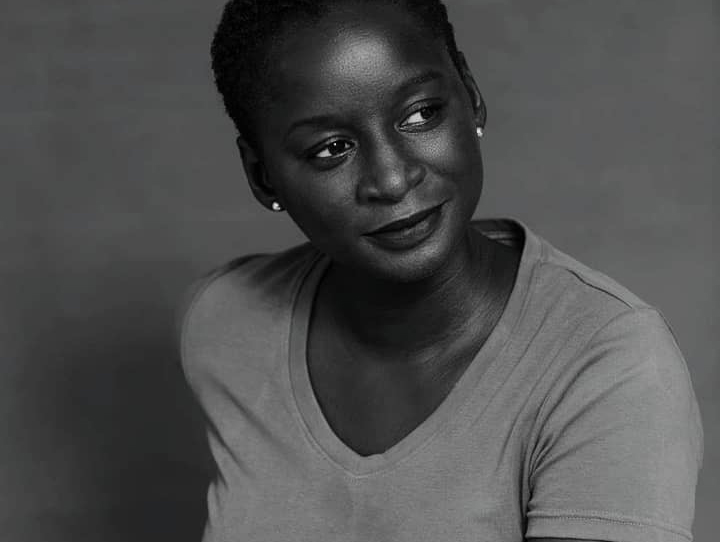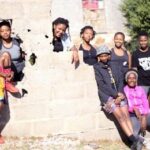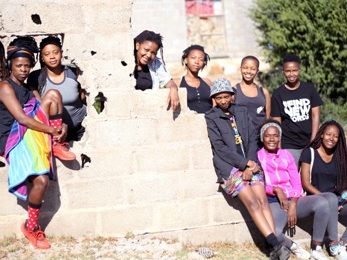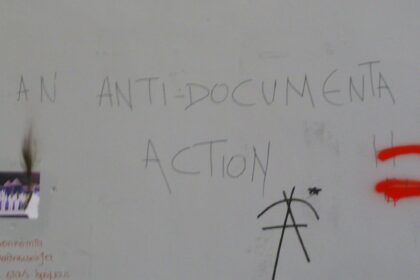Interview with Marie Hélène Pereira – Director of Programs RAW Material Company – Centre for Art, Knowledge and Society
Nomusa Makhubu
Introduction
Based in Dakar, Senegal, RAW Material Company was established in 2008 as a project fostering collaborative knowledge sharing and experimentation. It was founded by Koyo Kouoh: artistic director and independent curator. By 2011, it found physical location in the city of Dakar. Its name, as explained by Kouoh, is a concept that connotes “art as raw material for human and social development.”[1] It also refers to Africa as the provider of raw material to the rest of the world. While the word “company” defines cultural entrepreneurship, it also signifies togetherness, kinship and collaboration. In Wolof, Kouoh explains, “raw” means pioneer. [2] As an alternative space, RAW Material Company is a resource center (RAW Base) with a transdisciplinary study program (RAW Académie) and a residency for local and international artists (Ker Issa).

©Antoine Tempé
Initially, RAW presented exhibitions, symposia (notably Condition Report 1-4), and held weekly discussions as well as a residency program but later developed RAW Académie given the growing need for spaces that nurture learning and, as Kouoh says, unlearning as an important part of intellectual growth. Since 2016, the RAW Académie has hosted eight-week sessions twice a year that are led by scholars and art professionals. Providing space for alternative education and experimental social pedagogies, the sessions nurtured the dissemination of knowledge without the institutional bureaucratic burden of formal qualifications. This, in response to the needs of art communities, is an example of the significance in flexibility and responsiveness of RAW Material Company to its environment.
Independent spaces based on the African continent bear significance because they catalyze debates about transnational engagement, mobility and collaboration. RAW Material Company follows in the illustrious historical trajectory of critical socially responsive artists movements and collaborative artists’ spaces in Senegal and beyond. For example, Laboratoire Agit’art, which was founded in 1973 by Issa Samb, Djibril Diop Mambéty, El Hadji Sy and Youssoupha Dione, created dynamic interdisciplinary interventions. Members of Laboratoire Agit’art were critical of state institutionalism and on the impositions its patronage had on creative work. As president between 1960 and 1980, Senghor developed cultural institutions to realize his negritudinist cultural policy, which reinforced a specific limited and, as argued by its critics, essentialist sense of African aesthetics. As a leftist movement, it became a space where art is not just presented, but it was a space to think and to generate intellectual discourse on its political context. It follows, therefore, that in 2014 Kouoh curated Parole! Parole? Parole! Issa Samb Et La Forme Indéchiffrable—a well-conceived exhibition of Issa Samb’s work at RAW Material Company.
Around the time when RAW Material Company was physically established it was in the milieu of the emergence of youth movements such as Y’en a Marre and M23 who opposed the re-election of Abdoulaye Wade whose multiple terms were marred by corruption. Following the protests against Wade’s re-election in 2011, RAW Material Company exhibited Chronicle of a Revolt: Photographs of a Season of Protest in 2012 documenting civil uprisings and advancing discussions about citizenship, power and collective governance.
In this interview, Marie Hélène Pereira, its Director of Programs, reflects on RAW material company’s work and her role in the institution. Pereira joined RAW in 2011 where she has organized exhibitions and related discursive programs including the participation of RAW Material Company in “We face forward: Art from West Africa Today” Whitworth Art Gallery, Manchester; ICI Curatorial Hub at TEMP, New York; The 9th Shanghai Biennial, Shanghai; MARKER Art Dubai (2013). She co-curated Scattered Seeds in Cali, Colombia (2015-2017) and curated Battling to Normalize Freedom at Clarkhouse Initiative in Mumbai, India (2017) among other projects. She was a co-curator of Canine Wisdom for the Barking Dog/The Dog Done Gone Deaf: Exploring The Sonic Cosmologies of Halim El-Dabh with Dr. Bonaventure Ndikung at the 13th edition of Dakar Biennale of Contemporary African Art (2018). She has a strong interest in politics of identity and migration histories.
Nomusa Makhubu: In this Special Issue, we focus on social engagement in the arts, and particularly on the continent. We are particularly interested in RAW because it is not just about the gallery, the audience walking in and buyers. It is more about the social impact of art—the creation of knowledge. Prior to delving in to RAW, I wanted us to first maybe speak about you; and how you define your work. You shifted from Business & Law to Art. So, what made you decide to change and how would you define your work now as a curator?
Marie Hélène Pereira: My practice developed in an interesting way indeed, RAW was the starting point when it comes to artistic knowledge and related practices. After my studies in what I would call the basic curriculum I started a career in the business world, having worked in a telecommunication company then in a bank. From one task to another I quickly felt a lack of interest in the machinery that was the bank. It wasn’t stimulating, there was no intellectual challenge for me, I felt bored. There was of course the social pressure that needs you to be employed, to earn a lot of money, to drive a car, own a house etc… and if we extend it to the full package, there was the pressure to be married and build a family… you know “the perfect life” according to our society!
What I felt was missing the most in that financial field is the importance of building relationships that would go beyond a bank transaction. I wasn’t an ounce fulfilled; I left the bank.
The human interactions, encounters, conversations that I was craving for are what I found at RAW after leaving the bank. I met with Koyo when she was in the process of opening the center and was part of the team in 2011. It wasn’t an easy path knowing that I was freshly introduced to the art world, it was very challenging and full of adrenaline, I loved that!
My first position at RAW was related to communication and management, which made sense. Then I got more and more involved in the programming, the exhibition production, the residency coordination etc… The challenges were big, but I was ready for it. I did a lot of research, had a lot of conversations with people who had a similar path, observed what was happening at RAW and around me, learnt from my mistakes. Most of the team at RAW learnt by doing, Koyo has been very generous by opening doors for younger generations to find their way. She often says “I like to throw you in the water and let you learn how to swim… I won’t let you drown”.
Today my practice as a curator is defined as a facilitator, I would say. Even though exhibition making is important to it, my main interest is to create possibilities of encounters, of sharing ideas and learning from each other. My research interest focuses on migrations and politics of identity, I find it important to understand who we are as human beings with a particular belonging, but also to know more about other types of beings that surround us.
NM: And if you were to reflect back on previous projects like Scattered Seeds (2015-2017), Battling to Normalize Freedom (2017) and others, what are your thoughts about their impact?
MHP: Scattered Seeds is a project done with my friends/colleagues Sally Mizrachi from Lugar a dudas (Cali, Colombia), Ana Garzon Sabogal from Mas Arte Mas Accion (Bogota, Colombia) and Molemo Moiloa from VANSA (Johannesburg, South Africa). It came into being during an institutional residency that happened in the framework of the Arts Collaboratory network, the idea being to hold spaces for exchange and learning from the host institution and its context. My personal experience in Colombia was very strong, it’s a place that felt like home on day one.
I didn’t have a particular agenda when I was preparing to go except the desire to know the context and have a better understanding of the work done by my colleagues. But when I got there the very first encounters with the city happened with people from the Afro-Colombian community, my people, which of course made me want to dig more. The main idea of the project was to create a space of encounter with our peers whom blackness was very strongly put forward in their day-to-day experiences.
One of the artists that we invited for this project, Satch Hoyt, worked with a women’s association named Las Ensortijadas in order to revisit the passing down of knowledge through hair rituals. They are a group of about 20 ladies, aged around 25-30 back then, who engaged in a fight for recognition and respect of their black identity through the politics of hair. Through their collaboration with Hoyt on the performance piece Hair Combing Cycle, they took an opportunity to intervene in the space of the Museo La Tertulia and call for a representation of their history as well. When I reflect back today, especially when seeing how much their collective work has gone to reflect on racial violence, the valuing of traditional knowledge, black theory and community empowerment, intellectual artistic inquiry, among others, I can’t help but think that we have contributed to a change for them. It becomes even more relevant when seeing what is happening today triggered by the murder of George Floyd and the whole Black Lives Matter movement that gets more powerful around the world.

The project in Colombia continued with another residency with artist Dineo Seshee Bopape who has been exploring traditional healing practices in the region of Chocó.
Battling to Normalize Freedom was an exhibition reflecting on racial violence in the context of Mauritania through the work of artist Saleh Lo who denounces ongoing slavery practice in the 21st century, can you imagine? I also wanted to touch on racial alienation, the violence inflicted on the black body through skin whitening with works by Aissatou Diop (Senegal) and Amol Patil (India).
Clarkhouse Initiative was the perfect space for this exhibition knowing how avant-garde their work was and how much they engaged in the fight for minorities in India and Mumbai in particular.
NM: Let’s talk about RAW: so you joined in 2011 but it was established in 2008, and I think from 2008 it was still a mobile project – would you have the institutional memory to compare it to what it was when it was mobile as opposed to now that it is located in one place?
MHP: Oh my God, that’s a difficult question. Actually, Koyo says 2008, but I believe that RAW started way before knowing that it was in the making in her imaginary. It was legally set as an institution in 2008. Through her practice as an independent curator the years before the establishment of RAW, she built on different experiences until the birth of the institution, that shouldn’t be taken out of the process of creation. I don’t have a good memory of what happened from 2008 to 2011, I wasn’t born yet!
I do know that they are a couple of projects that Koyo have been working on, one that is related to poetry on the African continent and another one that is related to architecture and urbanism to which she was invited by Sir David Adjaye. I remember her saying that it was important to exhibit art spaces for that project instead of artworks only. She also worked on a couple of discursive programs and mentoring for cultural mediation in Senegal.
RAW being grounded somewhere was necessary in order to grow stronger in a given context and to contribute to what was already in place.
First President of Senegal Leopold Sedar Senghor was a poet and writer who played a crucial role in building institutions that will put art and culture at the heart of the society. He created an important system to support artistic production in Senegal, among them the École de Dakar, the Manufactures de Thies, Dak’art Biennale of Contemporary African Art. On another side we also had the Laboratoire Agit’art, which played an important card into the revindication of the space of contemporary art as a space to be used to express traditional beliefs and belonging. Their practices were very strong and reflected the realities of the people. The Laboratoire Agit’art paved the way to different generations of artists and citizens who deeply felt their role in shaping, re-shaping or building a better society in which art and culture would gain due recognition.
Establishing RAW in such a context was then very delicate as it was important to find the right way in which its contribution could be valuable and necessary. Storytelling became then very important in our practice, as it was important to archive the ways in which contemporary artistic practice evolved in Senegal, our direct context, and beyond. Its main intention was to fill a void by creating a space for deep reflection and criticism around artistic and curatorial practice. A center for art, knowledge and society that finds its relevance in opening up the discourse around art and related practices that are not necessarily understood or given the value they deserve. Such a work needed to be set on a solid ground.
NM: And looking back now on some of the projects of RAW: The Condition Report: Symposium on Artistic Education in Africa and the Academy, how would you, in thinking about the different strategies to bring people in, characterize the impact of RAW in its local environment?
MHP: The type of programming brought by RAW was very new to the context of Dakar, it was actually one of the reasons why we didn’t only focus on the production of artworks and its chain of visibility but engaged into a constant production of ideas. We always insist to correct when people call us a gallery, we are not a gallery. Critical thinking and theory are very important for us, they are key. Art professionals and non-art related engaged actors are invited to think together with us, about artistic and curatorial practice, yes. But also, about things that matter for a better understanding of our role in society. I stay humble when saying this, but I really think that RAW became a space that contributed to the understanding and recognition of the value of artistic practice beyond just the aesthetics.
Our programming touches on numerous subjects but what they have in common is that you can directly say that the initiative is from an African centered perspective, that is essential. Dakar, Senegal, Africa is/are our points of departure. Another important aspect to point out is how the space became a hub for many, a place of encounters and mutual learning.
NM: Yes, absolutely. RAW brings different people together. How has RAW managed to be so resilient over such a long space of time? Arts organizations and arts spaces always contend with balancing funding and resources. How has RAW managed to extend its programs for this long?
MHP: Well, your question touches two different points. One is about sustainability of ideas and the other one about financial sustainability for the institution. Sustainability of ideas, I think, is a matter of vision and sense of urgencies. We have been putting all our questions on the table through time and found ways to address them with entities that surround us (individual beings, private and public institutions, allies, entities we struggle to understand but need to orient an attentive ear to etc.). Being flexible and open has also been very important in order to have the ability to react to the needs of our context. This can be very challenging, but we gave it a try most of the time, you can take the different transformational phases at RAW as a reference. We started with a sustained exhibition making component to our programming, accompanied by artists in residency program, series of talks, discussions, and symposia but at some point decided to focus more on education which led to the launch of our study program RAW Académie in our ninth year of existence after completing a sabbatical year that was crucial in reflecting about our work and how it should continue in order to still keep its essence and importance in a context like Senegal and the African continent. It was crucial to reevaluate and reshape our contribution. Condition Report, the biennial symposia series that we started in 2012, was important to establish a collective thinking platform on which key voices from the African context could gather, exchange and create tools to sustain their work. This methodology of collectivity and togetherness also applies on the team structure of RAW where there has been a constant mentoring and empowering of each member in order to create diverse voices for the institution.
Financial sustainability, if there is such a thing for us, is the trickiest part for so called ‘medium and small scale’ institutions on the African continent. We are still facing a situation of insufficient support for independent initiatives even though they contribute consistently to the ecosystem. This situation keeps us very seriously dependent on western support, which is problematic. This is our biggest challenge.
Lately for instance, due to the Covid-19 crisis, the Government of Senegal released a fund for the cultural sector, you will be surprised if I tell you that it didn’t at first take into account the work of art professionals and institutions other than artists. This means that nearly 70% of practitioners have been left to figure themselves out in such a situation. When we asked about what was planned for us, a not-for-profit association, the answer was to knock at the door of the Ministry of Economics, Planning and the Cooperatives… can you imagine?
This is “une equation à mille inconnues” [an equation with a thousand unknowns] as we would say here.
After numerous revindication from different institutions and public intellectuals, a solution has been found to this and the support was extended to independent institutions and initiatives. Our question remains: why are we still today in a situation where we need to keep proving the value of our existence?
We have an urgency that requires to build trustful relationship with our supporters, which makes the list shrink quickly depending on the funder’s agenda. It’s been very important for us to keep our integrity despite the need for funding support, financial sustainability thus remains a utopia still.
NM: One other aspect that I guess we are trying to address is thinking about the different publics. It is also an assumption because in our various contexts there are different definitions of “the public” and there are class and racial differences. I wondered maybe if we could broaden the conversation now in terms of the broader context and how RAW experiences the Senegalese public or at least the Dakar public and different publics with different social politics that sometimes make it difficult to reach all audiences or as many audiences?

MHP: In the case of RAW it’s important to talk about ‘publics.’ Every time someone asks us ‘who is your public?’ it is difficult for us to reply in one word. We have different publics depending on the programs, their themes and the guest speakers. The main public is art related, but looking at the overall, we can name scholars, students, activists, writers, architects, chefs, professional from the humanities, university professors, etc. We are also very attentive to the community that we’ve created around us, so a program like Parlons Sénégalaiseries with journalist-satirist Ibou Fall, for instance, is very important as a way of inviting them to contribute to think together for building a stronger civil society. Our publics also have their role to play and we create situations for that to happen. There have been challenging moments of course, one of them being our addressing the question of homophobia in the African context, for example. There we saw strong limitations from the publics. It’s important to hear those limitations and give time for furthermore mediation in such cases. The resource center Raw Base also attracts its own public, people who are research focused visit it the most.

© Antoine Tempe
From one project to another, we encounter new comers. We worked with carapide (a local public transport bus) drivers, gardeners, street vendors, environmental activists from different backgrounds including farmers etc…
NM: This is a very broad question: What would you like to change in the artworld right now?
MHP: Wow! The question is even broader in the current crisis situation, both Covid-19 and the ongoing racism towards black people throughout the world.
Based on my little experience in the “artworld,” different encounters and conversations, visits to places and institutions, what I could say is it is very important to work further on is solidarity and clustering. What needs to change is the competition: we must walk side by side and work in support to each other instead of competing. Let’s be mindful of collective construction.
NM: That’s brilliant! Thank you so much. I really appreciate your time and insights.
Marie Hélène Pereira graduated in Management and International Business Law. After a few years of work within the business world, she shifted her professional interest to arts and culture. She is Director of Programmes at RAW Material Company where she has organized exhibitions and related discursive programs including the participation of RAW Material Company to “We face forward: Art from West Africa Today” Whitworth Art Gallery, Manchester; ICI Curatorial Hub at TEMP, New York; The 9th Shanghai Biennial, Shanghai; MARKER Art Dubai (2013). She co-curated Scattered Seeds in Cali-Colombia (2015-2017) and curated Battling to normalize freedom at Clarkhouse Initiative in Mumbai, India (2017). Pereira was a co-curator of Canine Wisdom for the Barking Dog – The Dog Done Gone Deaf. Exploring The Sonic Cosmologies of Halim El-Dabh with Dr. Bonaventure Ndikung at the 13th edition of Dakar Biennale of Contemporary African art (2018). She has a strong interest in politics of identity and histories of migration.
Nomusa Makhubu is an associate professor in Art History and deputy dean of transformation in Humanities at the University of Cape Town. She was the recipient of the ABSA L’Atelier Gerard Sekoto Award in 2006 and the Prix du Studio National des Arts Contemporain, Le Fresnoy in 2014. She received the American Council of Learned Societies (ACLS) African Humanities Program fellowship award and was an African Studies Association (ASA) Presidential fellow in 2016. In 2017, she was also a UCT-Harvard Mandela fellow at the Hutchins Centre for African and African American Research, Harvard University. Recognizing the need for mentorship and collaborative practice in socially responsive arts, she founded the Creative Knowledge Resources project. She co-edited a Third Text Special Issue: ‘The Art of Change’ (2013) and co-curated with Nkule Mabaso the international exhibition, Fantastic, in 2015 and The stronger we become in 2019 at the 58th Venice Biennale in Italy.
Notes
[1] Kouoh, K. “I is for Institute: Raw Material Company”, Lecture presented at the Institute of Contemporary Art (ICA), Philadelphia, 2018, https://vimeo.com/275892584 accessed 3 June 2020.
[2] Ibid.











